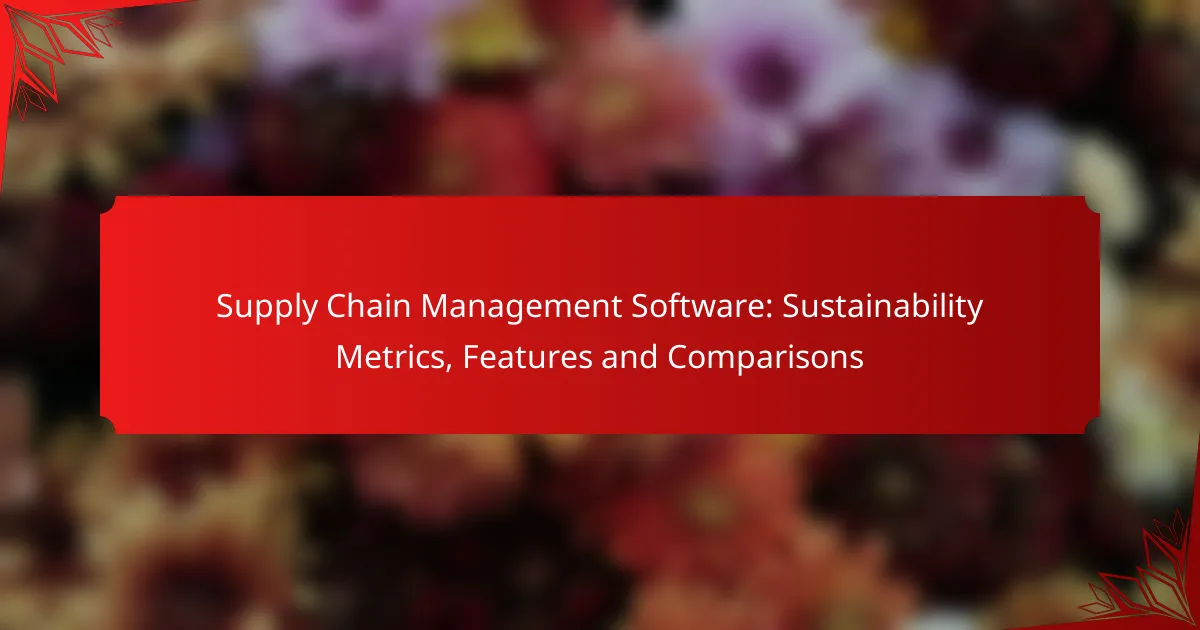Data analytics plays a crucial role in enhancing decision-making processes within organizations by transforming raw data into actionable insights. By leveraging advanced tools and techniques, businesses can identify trends and patterns that inform strategies, improve efficiency, and promote sustainability initiatives. This data-driven approach not only drives profitability but also helps organizations minimize their environmental impact through informed decision-making.
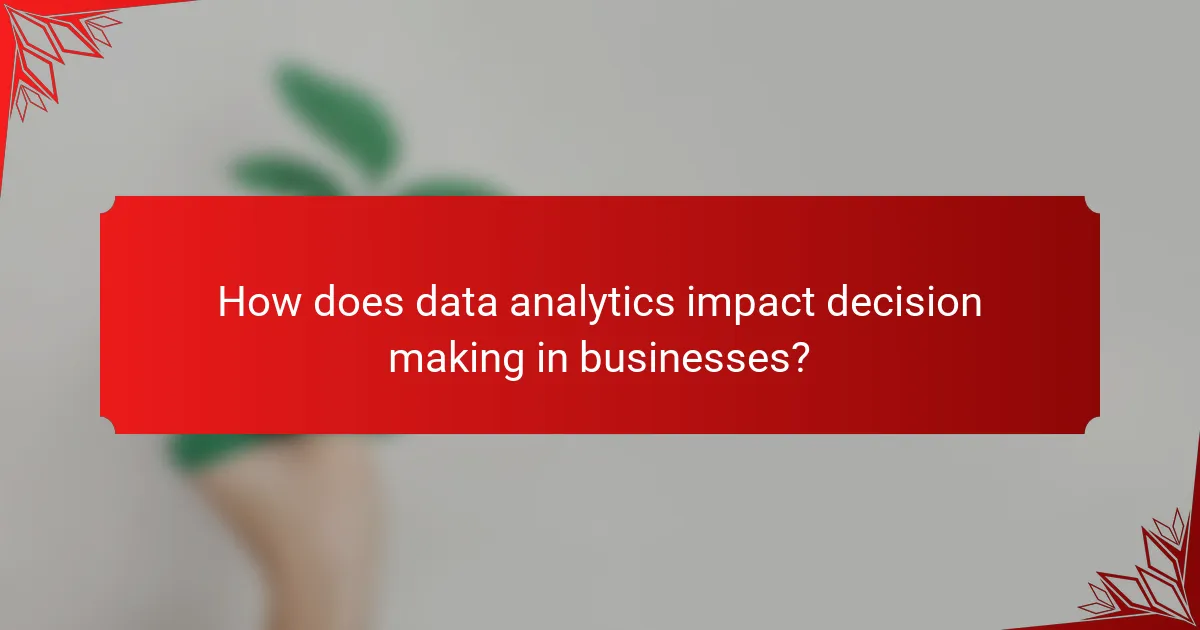
How does data analytics impact decision making in businesses?
Data analytics significantly enhances decision making in businesses by providing actionable insights derived from data. By analyzing trends and patterns, organizations can make informed choices that drive efficiency and profitability.
Improved forecasting accuracy
Data analytics enables businesses to predict future trends with greater precision. By utilizing historical data and advanced algorithms, companies can forecast sales, inventory needs, and market demands more accurately, reducing the risk of overstocking or stockouts.
For example, retailers can analyze seasonal buying patterns to optimize inventory levels, ensuring they meet customer demand without excess costs. This approach can lead to improved cash flow and reduced waste.
Enhanced customer insights
Through data analytics, businesses gain a deeper understanding of customer behavior and preferences. Analyzing customer interactions and feedback allows companies to tailor their products and services to meet specific needs, enhancing customer satisfaction and loyalty.
For instance, online platforms can segment their audience based on purchasing behavior, enabling targeted marketing campaigns that resonate more effectively with different customer groups.
Streamlined operational efficiency
Data analytics helps identify inefficiencies in business operations, allowing companies to streamline processes. By analyzing workflow data, organizations can pinpoint bottlenecks and areas for improvement, leading to optimized resource allocation and reduced operational costs.
Manufacturers, for example, can use analytics to monitor production lines in real time, making adjustments that enhance throughput and minimize downtime.
Data-driven risk management
Businesses can use data analytics to assess and mitigate risks more effectively. By analyzing historical data and current trends, companies can identify potential risks and develop strategies to address them proactively.
Financial institutions often leverage analytics to detect fraudulent activities by monitoring transaction patterns, allowing them to respond swiftly and minimize losses.
Informed strategic planning
Data analytics supports strategic planning by providing insights that inform long-term business goals. Companies can analyze market trends, competitive landscapes, and internal performance metrics to make informed decisions about future directions.
For example, a company considering expansion into a new market can use analytics to evaluate potential customer bases and competitive pressures, ensuring that their strategy is grounded in solid data rather than assumptions.
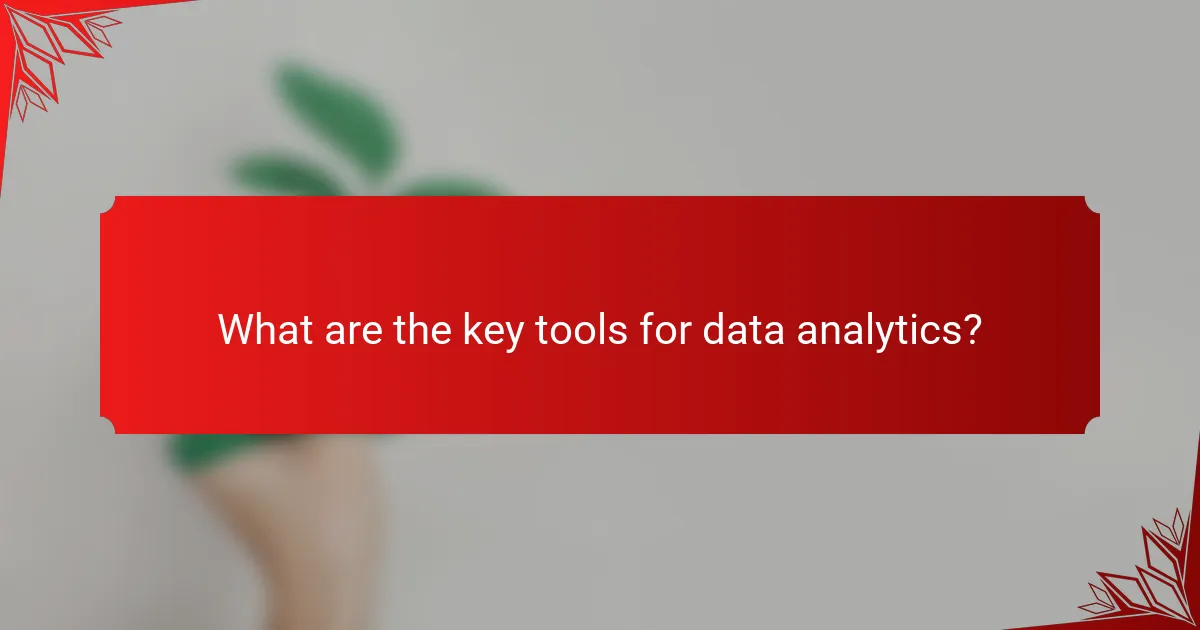
What are the key tools for data analytics?
Key tools for data analytics include software and platforms that help organizations collect, process, and visualize data effectively. These tools enable better decision-making and can significantly impact business strategies and sustainability efforts.
Tableau for data visualization
Tableau is a powerful data visualization tool that allows users to create interactive and shareable dashboards. It connects to various data sources and transforms raw data into visually appealing graphics, making complex data more understandable.
Users can drag and drop fields to create visualizations without needing extensive programming knowledge. This ease of use makes Tableau a popular choice for businesses looking to quickly analyze trends and insights from their data.
Google Analytics for web data
Google Analytics is a widely used tool for tracking and analyzing web traffic. It provides insights into user behavior, traffic sources, and conversion rates, helping businesses optimize their online presence.
By setting up goals and events, users can measure specific actions taken by visitors, such as purchases or sign-ups. This data is crucial for making informed decisions about marketing strategies and website improvements.
Microsoft Power BI for business intelligence
Microsoft Power BI is a business intelligence tool that enables users to visualize data and share insights across their organization. It integrates seamlessly with other Microsoft products, allowing for easy data import and analysis.
Power BI offers a range of data connectors and advanced analytics features, making it suitable for both small businesses and large enterprises. Users can create reports and dashboards that provide real-time insights into business performance.
Apache Spark for big data processing
Apache Spark is an open-source big data processing framework designed for speed and ease of use. It can handle large volumes of data across distributed computing environments, making it ideal for organizations dealing with big data analytics.
With its ability to process data in memory, Spark can perform tasks significantly faster than traditional disk-based processing. This efficiency allows businesses to analyze data in near real-time, facilitating quicker decision-making and responsiveness to market changes.
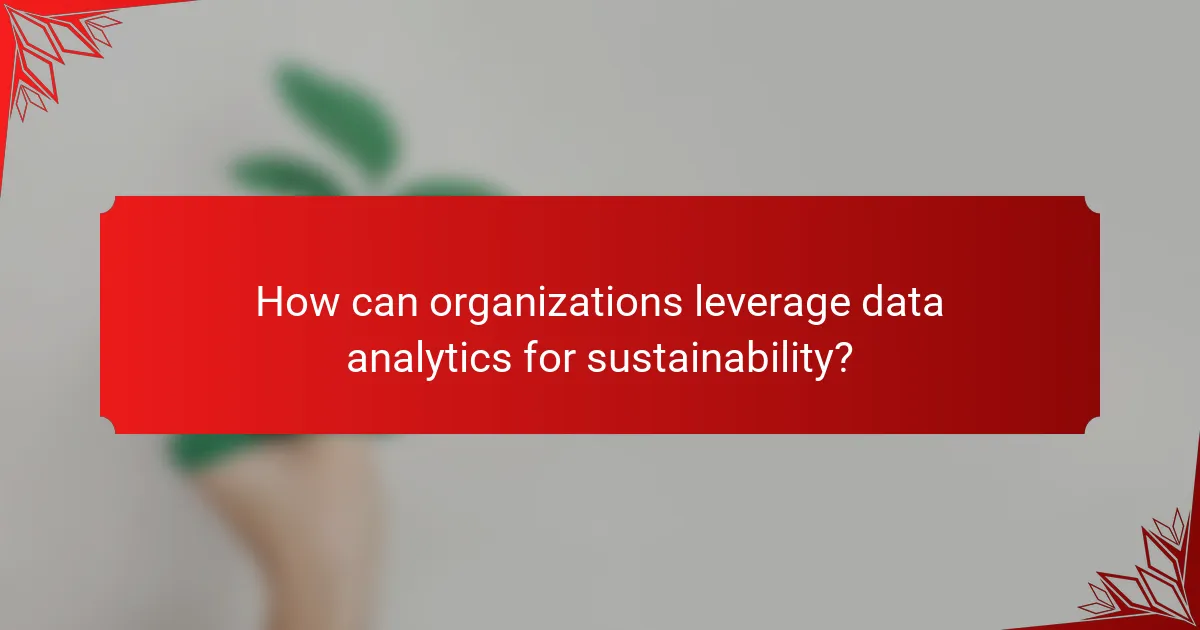
How can organizations leverage data analytics for sustainability?
Organizations can leverage data analytics for sustainability by using data-driven insights to make informed decisions that reduce environmental impact. This approach enables companies to identify inefficiencies, optimize processes, and track sustainability metrics effectively.
Reducing resource consumption
Data analytics helps organizations monitor and analyze their resource usage, such as energy, water, and raw materials. By identifying patterns and trends, companies can implement strategies to minimize waste and improve efficiency.
For instance, a manufacturing firm might use analytics to determine peak energy consumption times and adjust operations accordingly, potentially reducing energy costs by 10-20%. Regular audits and data tracking can further highlight areas for improvement.
Optimizing supply chain operations
Analytics can enhance supply chain efficiency by providing insights into inventory levels, transportation routes, and supplier performance. Organizations can use this data to streamline operations, reduce lead times, and lower emissions associated with logistics.
For example, a retailer might analyze sales data to optimize stock levels, reducing excess inventory and minimizing storage costs. Additionally, predictive analytics can help forecast demand, allowing for more sustainable sourcing practices.
Enhancing product lifecycle management
Data analytics supports product lifecycle management by tracking a product’s environmental impact from design to disposal. Companies can analyze data to identify opportunities for sustainable materials and processes throughout the lifecycle.
For instance, a tech company might use analytics to assess the recyclability of components in its devices, leading to design changes that facilitate easier recycling and reduce landfill contributions.
Measuring carbon footprint
Organizations can utilize data analytics to measure and track their carbon footprint, enabling them to set realistic sustainability goals. By collecting data on emissions from various operations, companies can identify key areas for improvement.
Implementing carbon tracking software can help businesses monitor emissions in real-time and report on their sustainability progress. This transparency can also enhance corporate reputation and align with regulations such as the EU’s Green Deal, which aims to reduce greenhouse gas emissions significantly by 2030.
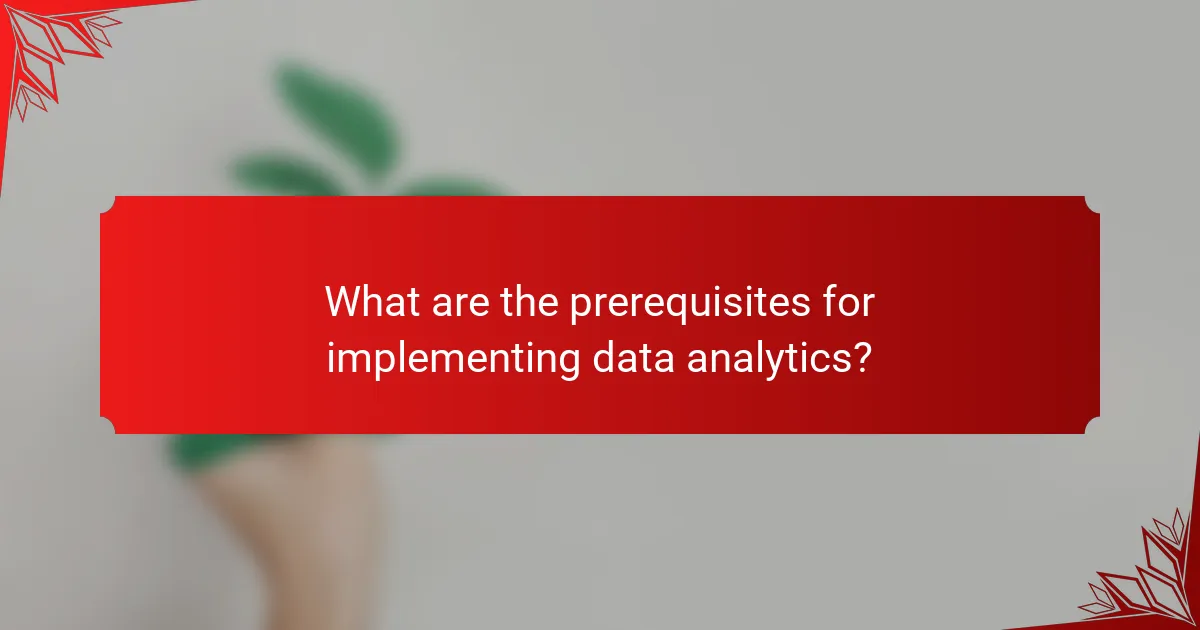
What are the prerequisites for implementing data analytics?
Implementing data analytics requires a solid foundation in data quality, skilled personnel, and a robust IT infrastructure. These elements ensure that data-driven insights are accurate, actionable, and sustainable over time.
Data quality and governance
Data quality is crucial for effective analytics. Organizations must establish clear data governance policies to ensure data accuracy, consistency, and reliability. This includes regular data cleansing processes and adherence to data management standards.
To maintain high data quality, consider implementing automated data validation tools and conducting periodic audits. Aim for a data accuracy rate of at least 95% to ensure reliable analytics outcomes.
Skilled personnel and training
Having skilled personnel is essential for leveraging data analytics effectively. This includes data scientists, analysts, and IT professionals who understand both the technical and business aspects of data. Investing in ongoing training helps keep the team updated on the latest tools and methodologies.
Consider offering workshops and certifications in data analytics tools like Python, R, or SQL. A well-trained team can significantly enhance the quality of insights derived from data.
Robust IT infrastructure
A robust IT infrastructure supports the storage, processing, and analysis of large data sets. Organizations should invest in scalable cloud solutions or on-premises servers that can handle increased data loads as analytics needs grow.
Ensure that your infrastructure includes strong security measures to protect sensitive data. Regularly assess your IT capabilities to align with evolving analytics technologies and practices.
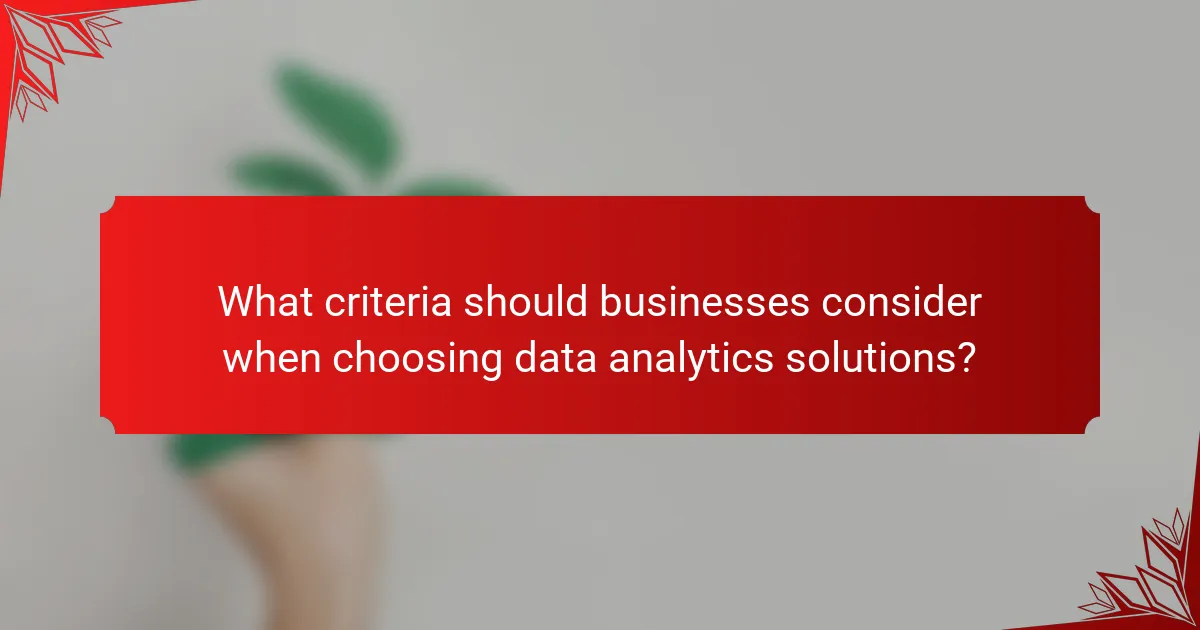
What criteria should businesses consider when choosing data analytics solutions?
When selecting data analytics solutions, businesses should focus on scalability, ease of integration, user-friendliness, and cost-effectiveness. These criteria ensure that the chosen solution aligns with the company’s current needs and future growth.
Scalability
Scalability refers to the ability of a data analytics solution to handle increasing amounts of data and users without compromising performance. Businesses should evaluate whether the solution can grow alongside their data needs, especially if they anticipate significant growth in the near future.
For instance, a cloud-based analytics platform may offer better scalability than an on-premises solution, as it can easily accommodate more data and users by leveraging additional cloud resources. Companies should consider solutions that allow for flexible scaling options, such as pay-as-you-go pricing models.
Ease of Integration
Ease of integration is crucial for ensuring that a data analytics solution can work seamlessly with existing systems and tools. Businesses should assess how well the solution connects with their current data sources, such as databases, CRM systems, and ERP software.
Solutions that offer robust APIs or pre-built connectors can significantly reduce the time and effort required for integration. Companies should also consider the potential need for custom development, which can add to the overall cost and complexity of implementation.
User-Friendliness
User-friendliness impacts how effectively team members can utilize the data analytics solution. A solution with an intuitive interface and straightforward navigation will enable users to quickly generate insights without extensive training.
Consider platforms that offer visual analytics features, such as drag-and-drop functionality, which can enhance accessibility for non-technical users. Providing training resources and support can also improve user adoption and satisfaction.
Cost-Effectiveness
Cost-effectiveness is a critical factor in choosing a data analytics solution, as it encompasses not only the initial purchase price but also ongoing operational costs. Businesses should evaluate the total cost of ownership, which includes licensing fees, maintenance, and potential costs for additional features or user licenses.
Comparing different pricing models, such as subscription-based versus one-time fees, can help businesses find a solution that fits their budget. It’s essential to weigh the costs against the expected return on investment (ROI) to ensure that the chosen solution delivers value over time.


